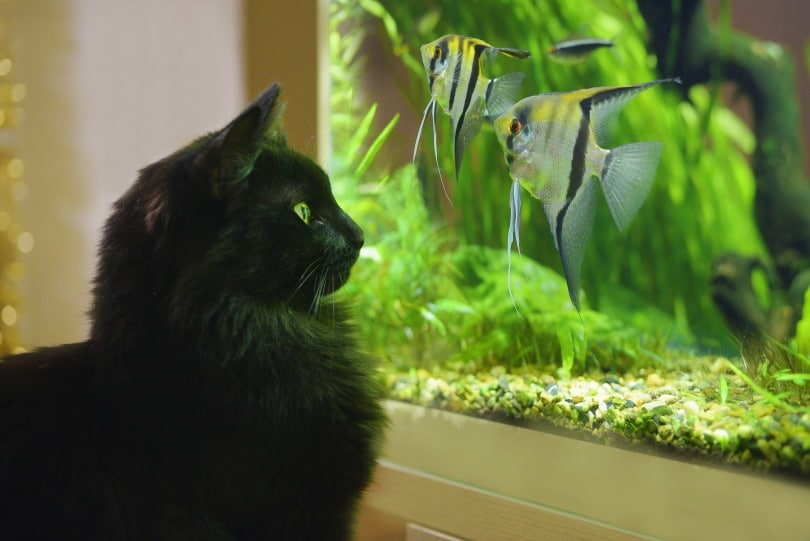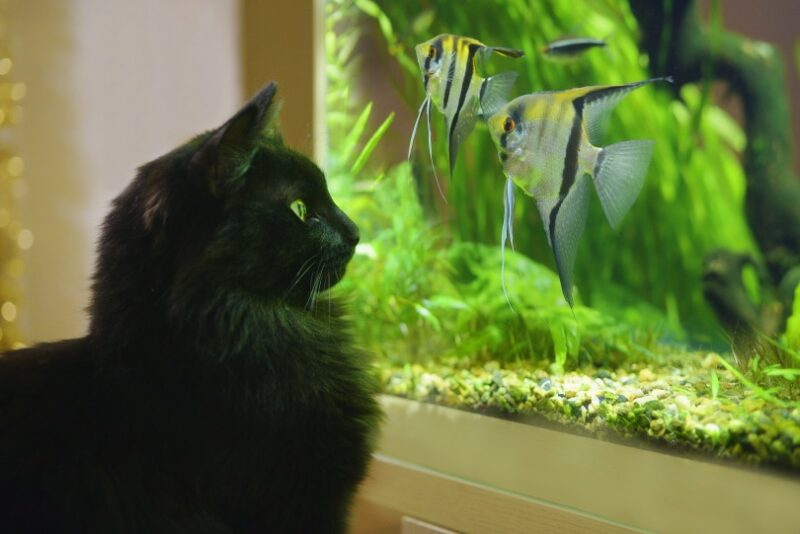Cats are drawn to quick, darting movements, and the colorful fish in the tank in your living room never fail to awaken their hunter’s instincts. Unfortunately, our cuddly kitties are never satisfied with admiring the glittery scales from afar.
More often than not, you’ll find your cat exploring places that you didn’t know that they could get to. While your cat might be well-behaved when you’re in the room, your fish are unprotected when you’re away. To reduce the risk of stressing your fish too much, here are seven ways to protect your fish tank from your cat.
How to Cat-Proof a Fish Tank
1. Aluminum Foil
Stopping your cat from jumping onto surfaces is easier said than done, but there are ways to convince them to leave the tank alone. You can place sheets of aluminum foil underneath the fish tank or on top of it. That way, when your cat jumps up, it’ll crinkle beneath their feet. Most felines don’t like the sound that the foil makes, and it’ll ward them off.
Replacing the aluminum foil can get expensive if your cat jumps on it repeatedly. Depending on how often your cat jumps up, you may have to replace the torn sheets more often.
- Cats don’t like the crinkling noise
- Easy solution
- Aluminum foil can be expensive

2. Cat Repellent
Some odors can encourage your cat to stay away. Citrus, like lemon, lime, and orange, is a scent that felines tend to avoid. You can also buy commercial cat repellent sprays, but some brands require you to reapply the treatment when the scent dissipates.
You can also get specially designed mats to deter cats. They work by using static-like pulses of low-powered electricity. While it’s harmless to your cat and will convince them not to jump on the aquarium, some owners consider electric deterrents cruel.
- You can make deterrent sprays at home
- Not all scents are cat-safe
- Some owners dislike using electric deterrents
3. Cover the Tank
Part of the reason that cats are so interested in fish tanks is the sight of the bright, colorful fish with their darting movements. If you’re out of the house, nothing will prevent your kitty from venturing closer to pester your fish.
One solution is to cover the tank when you’re at work or sleeping. You can use towels or an old blanket. However, there is a downside to covering the tank.
If you have a cat that likes to play with dangling fabric—curtains or a sweater on the back of a chair—they may pull down the whole thing. Make sure the tank and the blanket are secure. You could also use cardboard to cover the glass.
- Hides the fish from sight
- Recycles old blankets or cardboard
- Some cats will play with the blanket
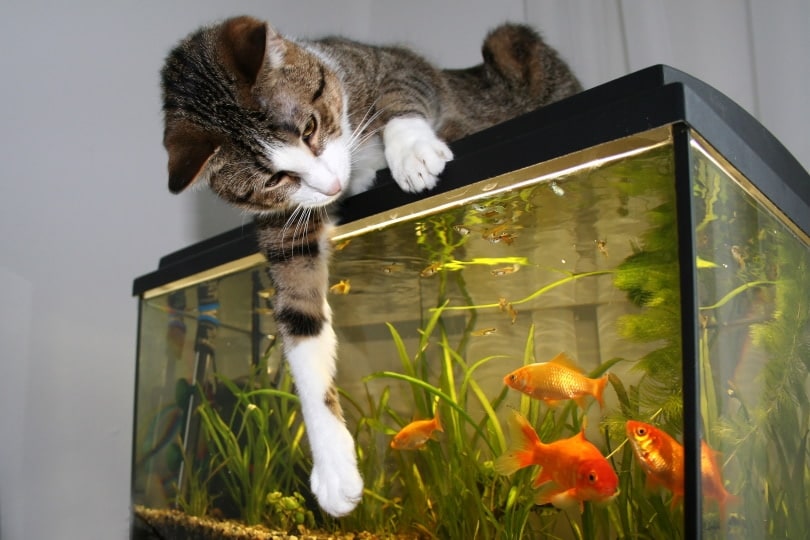
4. Create a Distraction
Distracting your cat can be handled in several ways and paired with other solutions for the best results. Leaving toys for your cat to play with while you’re at work can help. Puzzle toys, where they have to find the treats inside, will keep their attention off the fish in the tank.
Placing a cat tree next to a window overlooking your garden, if you have one, can help, too. The location will give your cat somewhere to sit while watching the birds visiting your yard.
- Works while you’re away
- Cat trees and toys can be expensive
5. Lidded fish tanks
Not all fish tanks come with lids, but the ones that do are useful for many reasons. The lids prevent the fish from escaping, keep debris and dust out of the water, and hold LED lights to help aquarium plants grow.
When it comes to your cat, a secure lid won’t stop them from jumping up, but it will prevent them from spending their day fishing. You can’t stop your fish from attracting your cat’s attention, but you can make them inaccessible to your kitty.
- Prevents cats from reaching your fish
- Doesn’t prevent cats from sitting on or by the tank
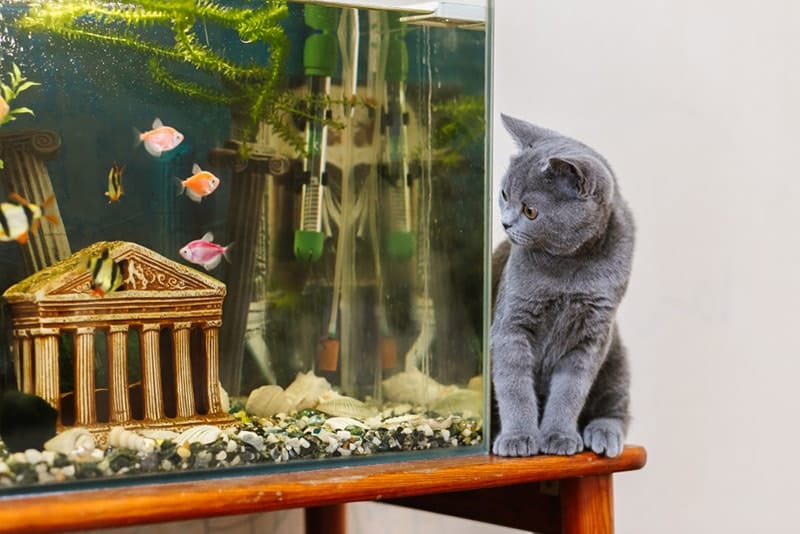
6. Shut the Door
When all else fails, leaving the fish tank in a secure room and shutting your cat out is the best method. It’s also the most successful, especially when you’re away at work or asleep. While it might seem cruel to refuse your cat access to one of the rooms in your house, they’ll eventually get used to it.
Without access to the fish they love to bother, your feline will find something else interesting, like taking a nap or playing with a stuffed toy. In the end, shutting the door is the only effective way to keep your cat away from your fish.
- Easy
- Effective
- The fish tank needs to be in a room with a door
7. Sticky Surfaces
One solution is to put double-sided sticky tape around the fish tank. Cats are picky about where they place their feet; it’s part of the reason they can be so fussy about the type of litter they use.
If you’ve ever walked barefoot across gravel or a rocky beach, you’ll know how sharp some objects can be to your sensitive feet. Cats are much the same way and will try to avoid surfaces that they don’t like walking across.
Sticky surfaces work simply because cats don’t like how it interferes with their paws.
- Cats don’t like having things stuck to their paws
- Double-sided tape can collect dirt
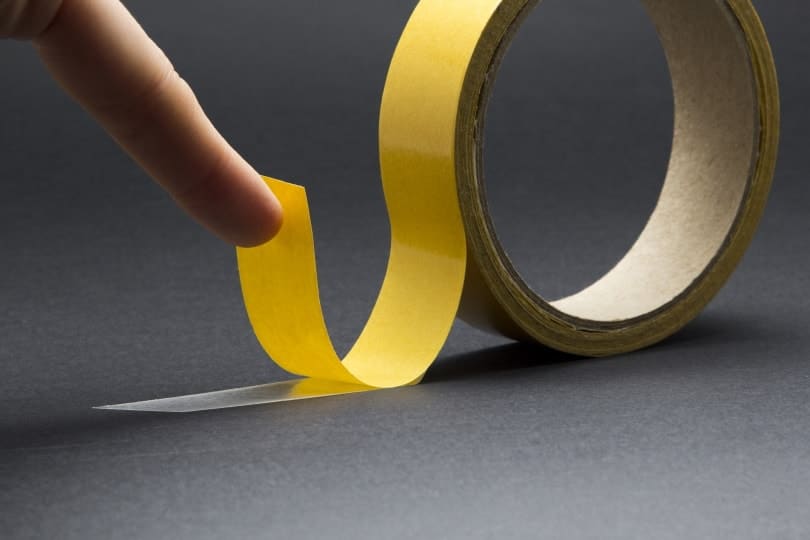
Conclusion
As hunting champions, cats will always take notice of prey creatures like fish. Their shimmering scales, bright colors, and darting movements all work to draw your cat’s attention. While it gives your cat something to focus on, your fish won’t appreciate having the attention of a predator.
The tips we discussed are all possible ways to keep your fish tank safe from your cat. Depending on your cat and how persistent they are, some methods will work better than others. When in doubt, keep your cat out of the room entirely and shut the door. Your fish will thank you for it.
Featured Image Credit: DMITRII STARTCEV, Shutterstock

